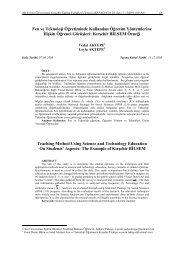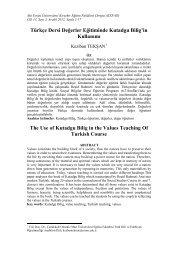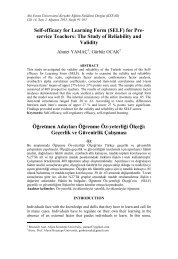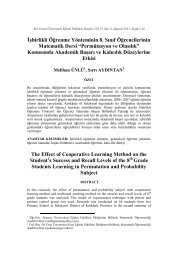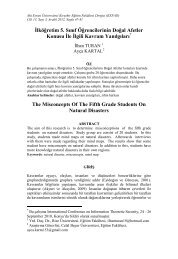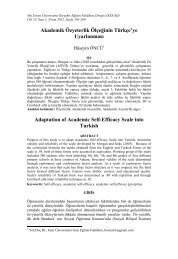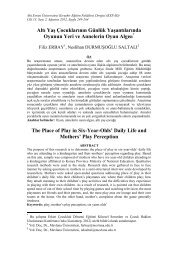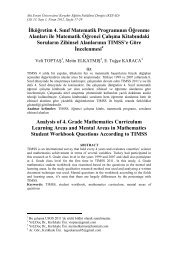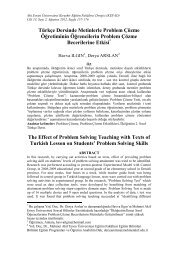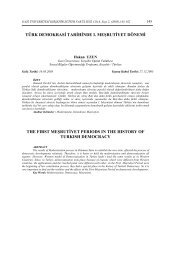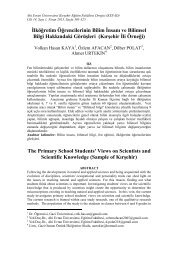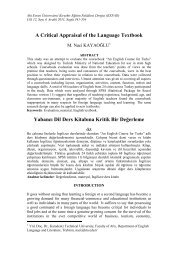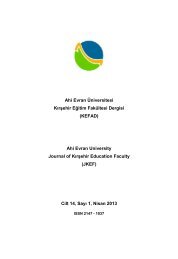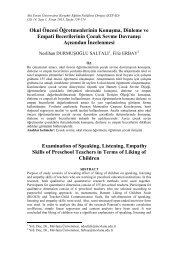Fizik Laboratuarına Yönelik Tutum ÃlçeÄi GeliÅtirme - KEFAD - Ahi ...
Fizik Laboratuarına Yönelik Tutum ÃlçeÄi GeliÅtirme - KEFAD - Ahi ...
Fizik Laboratuarına Yönelik Tutum ÃlçeÄi GeliÅtirme - KEFAD - Ahi ...
Create successful ePaper yourself
Turn your PDF publications into a flip-book with our unique Google optimized e-Paper software.
<strong>Ahi</strong> Evran Ünv. Kırşehir Eğitim Fakültesi Dergisi (<strong>KEFAD</strong>) Cilt 13, Sayı 3, Aralık 2012 97<br />
SUMMARY<br />
The aim of an effective science and technology education is to raise scienceliterate<br />
individuals who are capable of comprehending how to implement their<br />
knowledge to the changing society, environment, and changing technology,<br />
correlating everyday scientific and technological events, applying what they have<br />
learned to everyday life, and conducting research, investigating and obtaining<br />
results to interpret them (Hançer, Şensoy and Yıldırım, 2003).<br />
Described as one of the most important factors affecting learning, attitudes can<br />
positively or negatively affect the learning of individuals (Yaşar and Anagün,<br />
2008). According to Travers (1982), in the event to accepting or rejecting, some<br />
of the internal tendencies contravene attitudes, while the others contravene<br />
interests and values. Interests are preferences for activities, whereas attitudes are<br />
the positive approach to ideas or objects or the negative refraining from them (as<br />
cited in Köklü, 1995). There are many views on the definition of attitude.<br />
Thurstone (1931) defined attitude as a person’s ranking and evaluating “the<br />
affect for or against a psychological object” (as cited in Tavşancıl, 2002).<br />
According to Anderson (1988), attitude, with its cognitive, affective and<br />
behavioral aspects, is a psychological structure that is seen as a significant<br />
predictor of individual behavior (as cited in Yaşar and Anagün, 2008). To<br />
Tavşancıl (2002), the attitudes of an individual are “formed by the organization<br />
of his/her experiences and knowledge acquired”. According to Ekici (2002),<br />
“with its cognitive, affective and behavioral dimensions, attitude is an important<br />
descriptor of behavior”.<br />
Attitudes are not only a behavioral tendency or a feeling; they are the integration<br />
of cognition-emotion-behavior tendency. The cognitive elements of attitudes are<br />
the acceptance of the expression of a belief. In other words, attitudes contain our<br />
beliefs about objects. There is also a positive or negative belief towards that<br />
object. The emotional element of attitudes includes the excitement of the<br />
individual towards events or objects that is subject to attitude. This emotional<br />
element of attitude adds continuity to the attitude and it is the driving or molding<br />
element. The behavioral element of attitudes is about the tendency of an<br />
individual to act in accordance with his/her emotions and opinions (Tavşancıl,<br />
2002).<br />
The sample of the study was composed of 118 first-year candidate teachers<br />
enrolled to the Department of Primary Education Science Teaching at Faculty of<br />
Education, Kırıkkale University. For creating the attitude items of the scale, the<br />
second-year candidate teachers enrolled to Science Teaching were asked to write<br />
an essay in order to determine their views on the physics laboratory. In addition,<br />
the pre-application of the scale was prepared with 50 attitude items by means of<br />
literature review. This study used a 5-point Likert scale. Likert-type attitude



